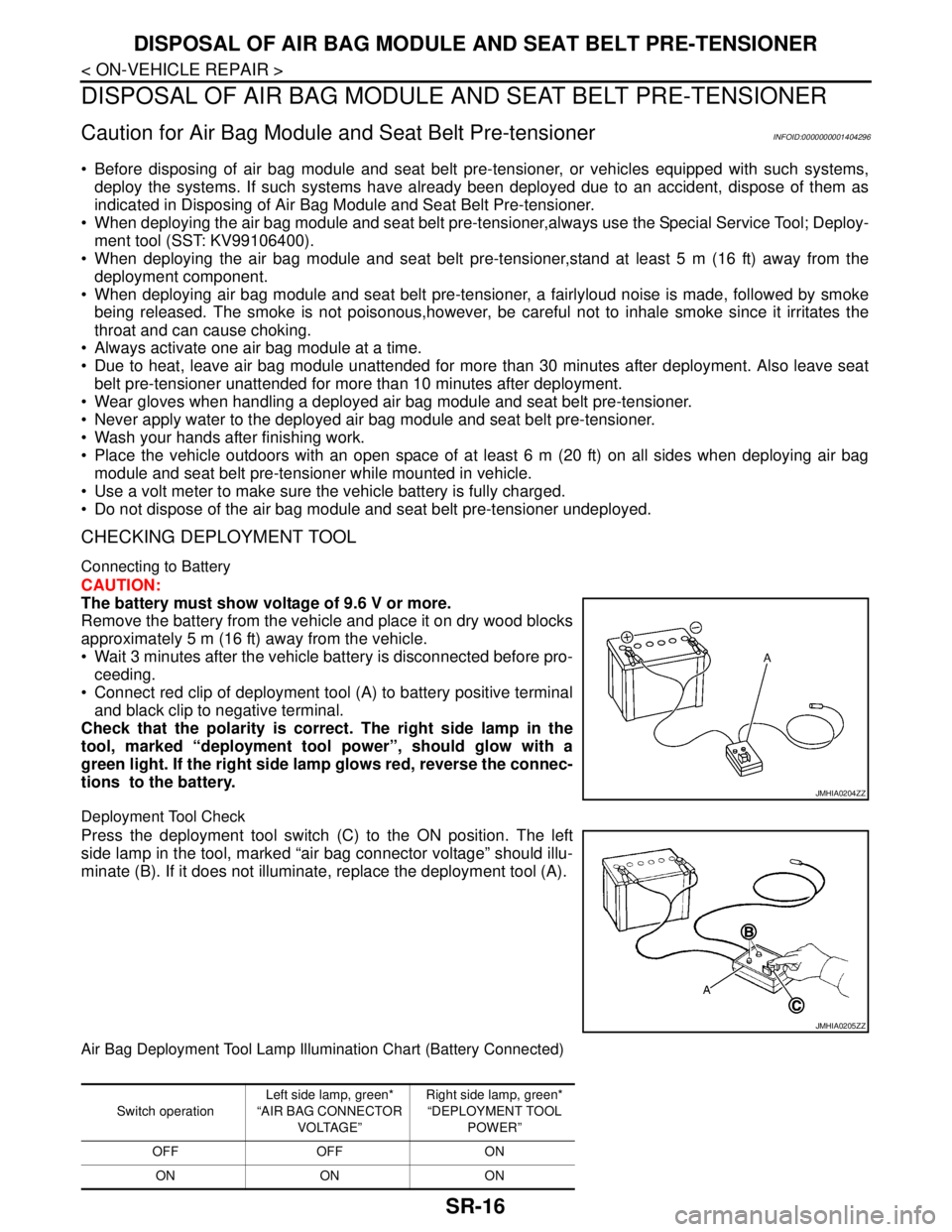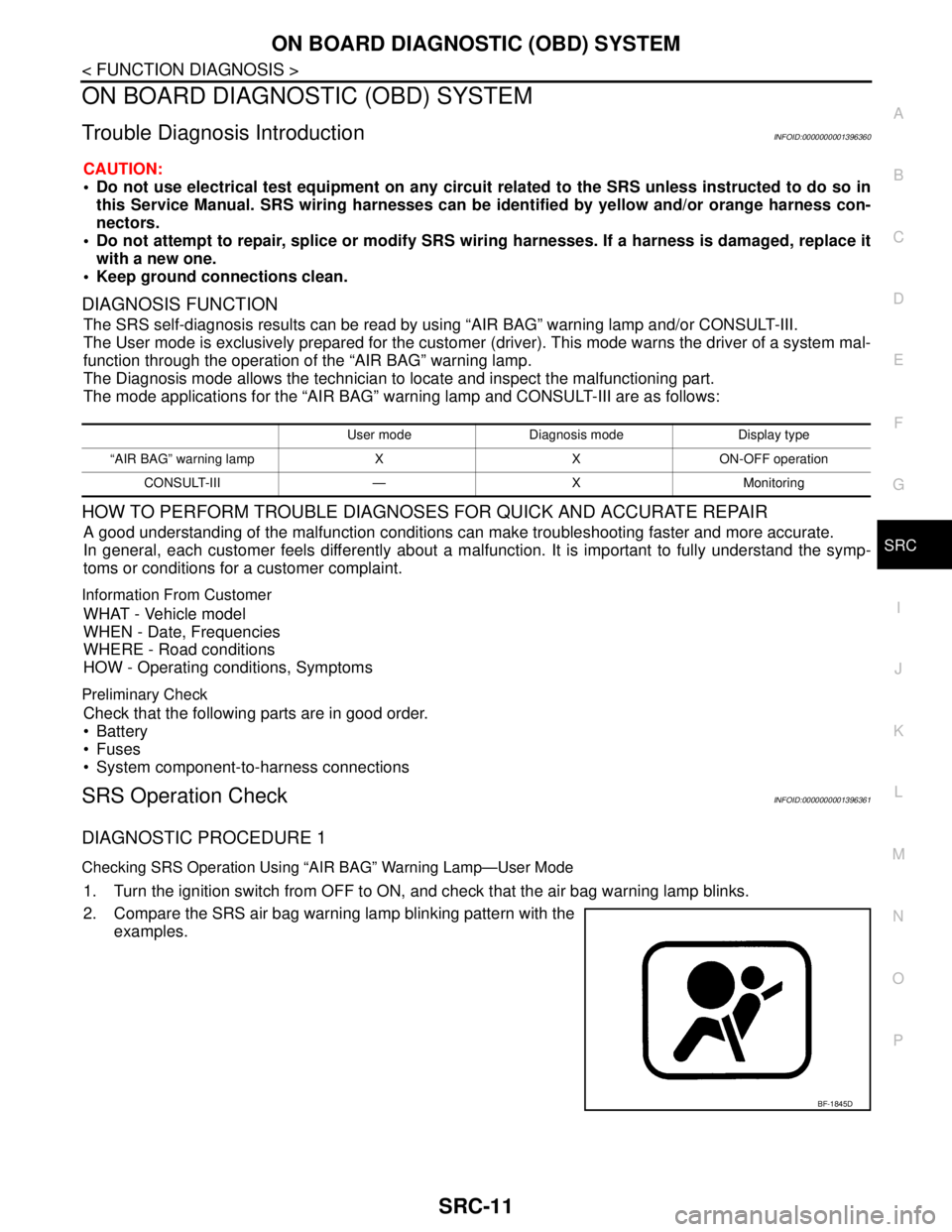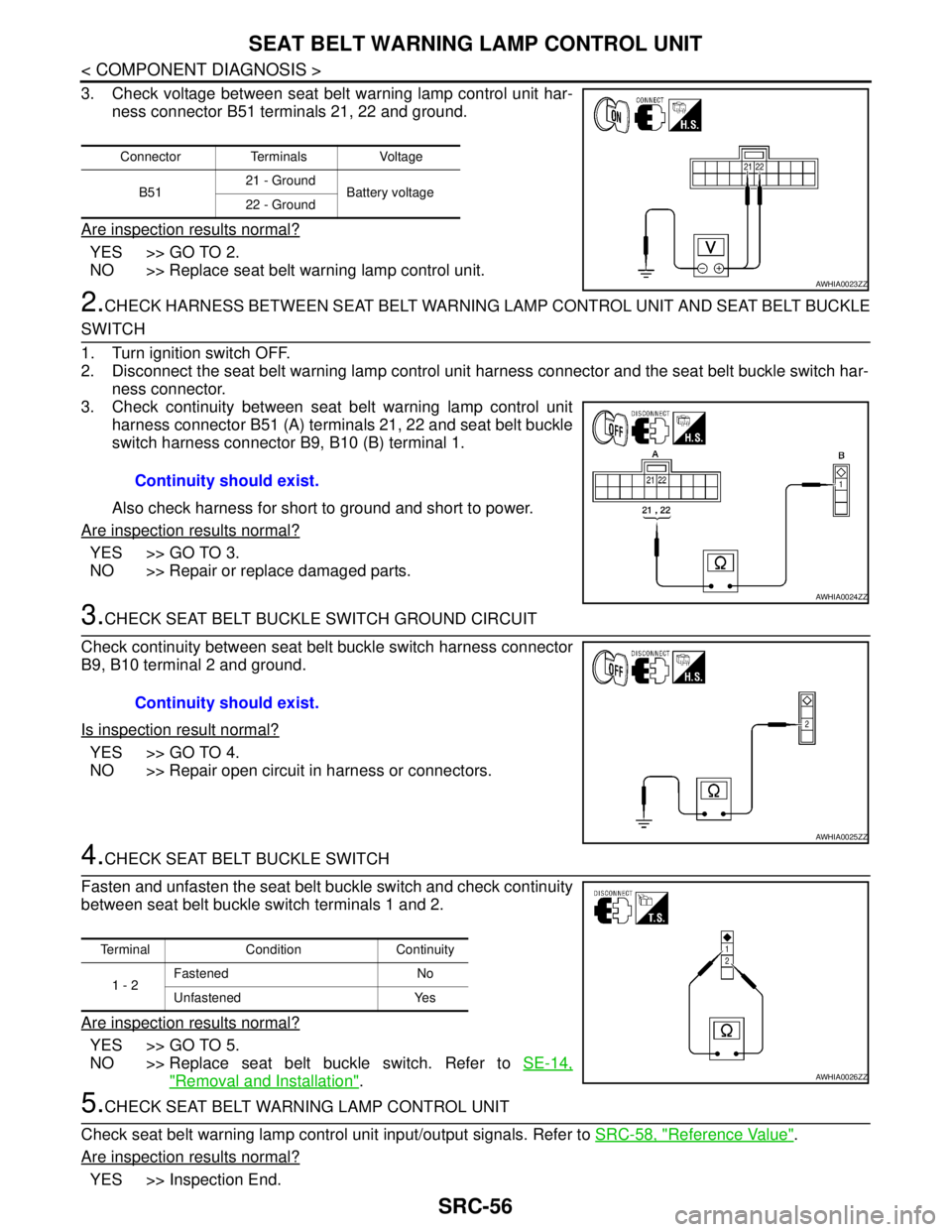2007 NISSAN TIIDA replace battery
[x] Cancel search: replace batteryPage 4759 of 5883

SR-16
< ON-VEHICLE REPAIR >
DISPOSAL OF AIR BAG MODULE AND SEAT BELT PRE-TENSIONER
DISPOSAL OF AIR BAG MODULE AND SEAT BELT PRE-TENSIONER
Caution for Air Bag Module and Seat Belt Pre-tensionerINFOID:0000000001404296
Before disposing of air bag module and seat belt pre-tensioner, or vehicles equipped with such systems,
deploy the systems. If such systems have already been deployed due to an accident, dispose of them as
indicated in Disposing of Air Bag Module and Seat Belt Pre-tensioner.
When deploying the air bag module and seat belt pre-tensioner,always use the Special Service Tool; Deploy-
ment tool (SST: KV99106400).
When deploying the air bag module and seat belt pre-tensioner,stand at least 5 m (16 ft) away from the
deployment component.
When deploying air bag module and seat belt pre-tensioner, a fairlyloud noise is made, followed by smoke
being released. The smoke is not poisonous,however, be careful not to inhale smoke since it irritates the
throat and can cause choking.
Always activate one air bag module at a time.
Due to heat, leave air bag module unattended for more than 30 minutes after deployment. Also leave seat
belt pre-tensioner unattended for more than 10 minutes after deployment.
Wear gloves when handling a deployed air bag module and seat belt pre-tensioner.
Never apply water to the deployed air bag module and seat belt pre-tensioner.
Wash your hands after finishing work.
Place the vehicle outdoors with an open space of at least 6 m (20 ft) on all sides when deploying air bag
module and seat belt pre-tensioner while mounted in vehicle.
Use a volt meter to make sure the vehicle battery is fully charged.
Do not dispose of the air bag module and seat belt pre-tensioner undeployed.
CHECKING DEPLOYMENT TOOL
Connecting to Battery
CAUTION:
The battery must show voltage of 9.6 V or more.
Remove the battery from the vehicle and place it on dry wood blocks
approximately 5 m (16 ft) away from the vehicle.
Wait 3 minutes after the vehicle battery is disconnected before pro-
ceeding.
Connect red clip of deployment tool (A) to battery positive terminal
and black clip to negative terminal.
Check that the polarity is correct. The right side lamp in the
tool, marked “deployment tool power”, should glow with a
green light. If the right side lamp glows red, reverse the connec-
tions to the battery.
Deployment Tool Check
Press the deployment tool switch (C) to the ON position. The left
side lamp in the tool, marked “air bag connector voltage” should illu-
minate (B). If it does not illuminate, replace the deployment tool (A).
Air Bag Deployment Tool Lamp Illumination Chart (Battery Connected)
JMHIA0204ZZ
JMHIA0205ZZ
Switch operationLeft side lamp, green*
“AIR BAG CONNECTOR
VOLTAGE”Right side lamp, green*
“DEPLOYMENT TOOL
POWER”
OFF OFF ON
ON ON ON
Page 4780 of 5883

ON BOARD DIAGNOSTIC (OBD) SYSTEM
SRC-11
< FUNCTION DIAGNOSIS >
C
D
E
F
G
I
J
K
L
MA
B
SRC
N
O
P
ON BOARD DIAGNOSTIC (OBD) SYSTEM
Trouble Diagnosis IntroductionINFOID:0000000001396360
CAUTION:
Do not use electrical test equipment on any circuit related to the SRS unless instructed to do so in
this Service Manual. SRS wiring harnesses can be identified by yellow and/or orange harness con-
nectors.
Do not attempt to repair, splice or modify SRS wiring harnesses. If a harness is damaged, replace it
with a new one.
Keep ground connections clean.
DIAGNOSIS FUNCTION
The SRS self-diagnosis results can be read by using “AIR BAG” warning lamp and/or CONSULT-III.
The User mode is exclusively prepared for the customer (driver). This mode warns the driver of a system mal-
function through the operation of the “AIR BAG” warning lamp.
The Diagnosis mode allows the technician to locate and inspect the malfunctioning part.
The mode applications for the “AIR BAG” warning lamp and CONSULT-III are as follows:
HOW TO PERFORM TROUBLE DIAGNOSES FOR QUICK AND ACCURATE REPAIR
A good understanding of the malfunction conditions can make troubleshooting faster and more accurate.
In general, each customer feels differently about a malfunction. It is important to fully understand the symp-
toms or conditions for a customer complaint.
Information From Customer
WHAT - Vehicle model
WHEN - Date, Frequencies
WHERE - Road conditions
HOW - Operating conditions, Symptoms
Preliminary Check
Check that the following parts are in good order.
Battery
Fuses
System component-to-harness connections
SRS Operation CheckINFOID:0000000001396361
DIAGNOSTIC PROCEDURE 1
Checking SRS Operation Using “AIR BAG” Warning Lamp—User Mode
1. Turn the ignition switch from OFF to ON, and check that the air bag warning lamp blinks.
2. Compare the SRS air bag warning lamp blinking pattern with the
examples.
User mode Diagnosis mode Display type
“AIR BAG” warning lamp X X ON-OFF operation
CONSULT-III — X Monitoring
BF-1845D
Page 4825 of 5883

SRC-56
< COMPONENT DIAGNOSIS >
SEAT BELT WARNING LAMP CONTROL UNIT
3. Check voltage between seat belt warning lamp control unit har-
ness connector B51 terminals 21, 22 and ground.
Are inspection results normal?
YES >> GO TO 2.
NO >> Replace seat belt warning lamp control unit.
2.CHECK HARNESS BETWEEN SEAT BELT WARNING LAMP CONTROL UNIT AND SEAT BELT BUCKLE
SWITCH
1. Turn ignition switch OFF.
2. Disconnect the seat belt warning lamp control unit harness connector and the seat belt buckle switch har-
ness connector.
3. Check continuity between seat belt warning lamp control unit
harness connector B51 (A) terminals 21, 22 and seat belt buckle
switch harness connector B9, B10 (B) terminal 1.
Also check harness for short to ground and short to power.
Are inspection results normal?
YES >> GO TO 3.
NO >> Repair or replace damaged parts.
3.CHECK SEAT BELT BUCKLE SWITCH GROUND CIRCUIT
Check continuity between seat belt buckle switch harness connector
B9, B10 terminal 2 and ground.
Is inspection result normal?
YES >> GO TO 4.
NO >> Repair open circuit in harness or connectors.
4.CHECK SEAT BELT BUCKLE SWITCH
Fasten and unfasten the seat belt buckle switch and check continuity
between seat belt buckle switch terminals 1 and 2.
Are inspection results normal?
YES >> GO TO 5.
NO >> Replace seat belt buckle switch. Refer to SE-14,
"Removal and Installation".
5.CHECK SEAT BELT WARNING LAMP CONTROL UNIT
Check seat belt warning lamp control unit input/output signals. Refer to SRC-58, "
Reference Value".
Are inspection results normal?
YES >> Inspection End.
Connector Terminals Voltage
B51 21 - Ground
Battery voltage
22 - Ground
AWHIA0023ZZ
Continuity should exist.
AWHIA0024ZZ
Continuity should exist.
AWHIA0025ZZ
Terminal Condition Continuity
1 - 2Fastened No
Unfastened Yes
AWHIA0026ZZ
Page 4855 of 5883

SRC-86
< PRECAUTION >
PRECAUTIONS
PRECAUTION
PRECAUTIONS
Precaution for Supplemental Restraint System (SRS) "AIR BAG" and "SEAT BELT
PRE-TENSIONER"
INFOID:0000000001396424
The Supplemental Restraint System such as “AIR BAG” and “SEAT BELT PRE-TENSIONER”, used along
with a front seat belt, helps to reduce the risk or severity of injury to the driver and front passenger for certain
types of collision. Information necessary to service the system safely is included in the SR and SB section of
this Service Manual.
WARNING:
To avoid rendering the SRS inoperative, which could increase the risk of personal injury or death in
the event of a collision which would result in air bag inflation, all maintenance must be performed by
an authorized NISSAN/INFINITI dealer.
Improper maintenance, including incorrect removal and installation of the SRS, can lead to personal
injury caused by unintentional activation of the system. For removal of Spiral Cable and Air Bag
Module, see the SR section.
Do not use electrical test equipment on any circuit related to the SRS unless instructed to in this
Service Manual. SRS wiring harnesses can be identified by yellow and/or orange harnesses or har-
ness connectors.
Precaution for SRS "AIR BAG" and "SEAT BELT PRE-TENSIONER" Service
INFOID:0000000001396425
Do not use electrical test equipment to check SRS circuits unless instructed to in this Service Manual.
Before servicing the SRS, turn ignition switch OFF, disconnect both battery cables and wait at least 3 min-
utes.
For approximately 3 minutes after the cables are removed, it is still possible for the air bag and seat belt pre-
tensioner to deploy. Therefore, do not work on any SRS connectors or wires until at least 3 minutes have
passed.
The air bag diagnosis sensor unit must always be installed with the arrow mark “⇐” pointing toward the front
of the vehicle for proper operation. Also check air bag diagnosis sensor unit for cracks, deformities or rust
before installation and replace as required.
The spiral cable must be aligned with the neutral position since its rotations are limited. Do not attempt to
turn steering wheel or column after removal of steering gear.
Handle air bag module carefully. Always place driver and front passenger air bag modules with the pad side
facing upward and seat mounted front side air bag module standing with the stud bolt side facing down.
Conduct self-diagnosis to check entire SRS for proper function after replacing any components.
After air bag inflates, the front instrument panel assembly should be replaced if damaged.
Page 4881 of 5883
![NISSAN TIIDA 2007 Service Repair Manual DIAGNOSIS SYSTEM (EPS CONTROL UNIT)
STC-7
< FUNCTION DIAGNOSIS >[EPS]
C
D
E
F
H
I
J
K
L
MA
B
STC
N
O
P
DIAGNOSIS SYSTEM (EPS CONTROL UNIT)
CONSULT-III Function (EPS)INFOID:0000000001697722
FUNCTION
CO NISSAN TIIDA 2007 Service Repair Manual DIAGNOSIS SYSTEM (EPS CONTROL UNIT)
STC-7
< FUNCTION DIAGNOSIS >[EPS]
C
D
E
F
H
I
J
K
L
MA
B
STC
N
O
P
DIAGNOSIS SYSTEM (EPS CONTROL UNIT)
CONSULT-III Function (EPS)INFOID:0000000001697722
FUNCTION
CO](/manual-img/5/57395/w960_57395-4880.png)
DIAGNOSIS SYSTEM (EPS CONTROL UNIT)
STC-7
< FUNCTION DIAGNOSIS >[EPS]
C
D
E
F
H
I
J
K
L
MA
B
STC
N
O
P
DIAGNOSIS SYSTEM (EPS CONTROL UNIT)
CONSULT-III Function (EPS)INFOID:0000000001697722
FUNCTION
CONSULT-III can display each diagnostic item using the diagnostic test modes shown following.
SELF-DIAG RESULTS MODE
Display Item List
CAUTION:
If “CAN COMM CIRCUIT [U1000]” is displayed with other DTCs, first perform the trouble diagnosis for CAN communication
line.
How to Erase Self-Diagnostic Results
1. Perform applicable inspection of malfunctioning item and then repair or replace.
2. Turn ignition switch “OFF” to erase memory.
3. Turn ignition switch “ON” and select “SELF-DIAG RESULTS” mode with CONSULT-III.
4. Touch “ERASE” on CONSULT-III screen to erase DTC memory.
CAUTION:
If memory cannot be erased, perform diagnosis.
DATA MONITOR
Display Item List
EPS diagnostic mode Description
SELF-DIAG RESULTS Displays EPS self-diagnosis results.
DATA MONITOR Displays EPS input/output data in real time.
CAN DIAG SUPPORT MNTR The result of transmit/receive diagnosis of CAN communication can be read.
ECU PART NUMBER EPS control unit part number can be read.
Item
(CONSULT-III screen terms)Diagnostic item is detected when.... Check item
BATTERY VOLT
[C1601]When the power supply malfunction supplied to EPS control unit is
detected.STC-9
TORQUE SENSOR
[C1604]When the torque sensor malfunction assembled in steering column
assembly is detected. STC-11
EPS MOTOR
[C1606]When the motor driver malfunction of EPS control unit or EPS motor
malfunction is detected.STC-13
EEPROM
[C1607]When the memory (EEPROM) system malfunction is detected in
EPS control unit.STC-15
CONTROL UNIT
[C1608]When the internal malfunction is detected in EPS control unit.STC-16
CAN VHCL SPEED
[C1609]When the malfunction is detected in vehicle speed signal received
with CAN communication.STC-17
CAN ENG RPM
[C1610]When the malfunction is detected in engine status signal received
with CAN communication.STC-19
CAN COMM CIRCUIT
[U1000]When EPS control unit is not transmitting or receiving CAN commu-
nication signal 2 seconds or more.STC-21
NO DTC IS DETECTED.
FURTHER TESTING MAY BE RE-
QUIRED.No NG item has been detected. —
Page 4884 of 5883
![NISSAN TIIDA 2007 Service Repair Manual STC-10
< COMPONENT DIAGNOSIS >[EPS]
C1601 BATTERY POWER SUPPLY
NG >> Check the following. If any items are damaged, repair or replace damaged parts.
60 A fusible link (letter m, located in the fuse NISSAN TIIDA 2007 Service Repair Manual STC-10
< COMPONENT DIAGNOSIS >[EPS]
C1601 BATTERY POWER SUPPLY
NG >> Check the following. If any items are damaged, repair or replace damaged parts.
60 A fusible link (letter m, located in the fuse](/manual-img/5/57395/w960_57395-4883.png)
STC-10
< COMPONENT DIAGNOSIS >[EPS]
C1601 BATTERY POWER SUPPLY
NG >> Check the following. If any items are damaged, repair or replace damaged parts.
60 A fusible link (letter m, located in the fuse and fusible link box).
10 A fuse [No. 2, located in the fuse block (J/B)].
Harness for short or open between battery and EPS control unit harness connector M54 termi-
nal 17.
Harness for short or open between ignition switch and EPS control unit harness connector M53
terminal 10.
2.CHECK EPS CONTROL UNIT GROUND CIRCUIT
1. Turn ignition switch OFF.
2. Disconnect EPS control unit harness connector.
3. Check continuity between EPS control unit harness connector
M54 terminal 18 and ground.
Also check harness for short to power.
4. Connect EPS control unit harness connector.
OK or NG
OK >> GO TO 3.
NG >> Repair open circuit, short to ground or short to power in
harness or connectors.
3.CHECK DTC
1. Start engine.
Does EPS warning lamp turn OFF?
YES >>INSPECTION END
NO >> Perform self-diagnosis, repair or replace damaged parts. Refer to STC-7, "
CONSULT-III Function
(EPS)".
Special Repair Requirement (Models with ESP)INFOID:0000000001716734
1.ADJUSTMENT OF STEERING ANGLE SENSOR NEUTRAL POSITION
Always perform the neutral position adjustment for the steering angle sensor, when replacing the EPS control
unit. Refer to BRC-90, "
ADJUSTMENT OF STEERING ANGLE SENSOR NEUTRAL POSITION : Descrip-
tion".
>> END
Connector Terminal Continuity
M54 18 Yes
AWGIA0029ZZ
Page 4905 of 5883
![NISSAN TIIDA 2007 Service Repair Manual EPS WARNING LAMP DOES NOT TURN OFF
STC-31
< SYMPTOM DIAGNOSIS >[EPS]
C
D
E
F
H
I
J
K
L
MA
B
STC
N
O
P
EPS WARNING LAMP DOES NOT TURN OFF
Diagnosis ProcedureINFOID:0000000001697734
SYMPTOM:
EPS warnin NISSAN TIIDA 2007 Service Repair Manual EPS WARNING LAMP DOES NOT TURN OFF
STC-31
< SYMPTOM DIAGNOSIS >[EPS]
C
D
E
F
H
I
J
K
L
MA
B
STC
N
O
P
EPS WARNING LAMP DOES NOT TURN OFF
Diagnosis ProcedureINFOID:0000000001697734
SYMPTOM:
EPS warnin](/manual-img/5/57395/w960_57395-4904.png)
EPS WARNING LAMP DOES NOT TURN OFF
STC-31
< SYMPTOM DIAGNOSIS >[EPS]
C
D
E
F
H
I
J
K
L
MA
B
STC
N
O
P
EPS WARNING LAMP DOES NOT TURN OFF
Diagnosis ProcedureINFOID:0000000001697734
SYMPTOM:
EPS warning lamp does not turn OFF for several seconds after starting the engine.
DIAGNOSTIC PROCEDURE
1.CHECK SELF-DIAGNOSTIC RESULTS
Perform self-diagnosis. Refer to STC-7, "
CONSULT-III Function (EPS)".
Is any malfunction detected by self-diagnosis?
YES >> Check the malfunctioning system.
NO >> GO TO 2.
2.CHECK EPS CONTROL UNIT POWER SUPPLY CIRCUIT
1. Turn ignition switch OFF.
2. Disconnect EPS control unit harness connector.
3. Turn ignition switch ON. (Do not start engine.)
4. Check voltage between EPS control unit harness connector
M53 (A) terminal 10 and M54 (B) terminal 17 and ground.
5. Turn ignition switch OFF.
6. Check voltage between EPS control unit harness connector
M53 (A) terminal 10 and M54 (B) terminal 17 and ground.
7. Connect EPS control unit harness connector.
OK or NG
OK >> GO TO 3.
NG >> Check the following. If any items are damaged, repair
or replace damaged parts.
60 A fusible link (letter m , located in the fuse and fusible link box).
10 A fuse [No. 2, located in the fuse block (J/B)].
Harness for short or open between battery and EPS control unit harness connector M54 termi-
nal 17.
Harness for short or open between ignition switch and EPS control unit harness connector M53
terminal 10.
3.CHECK EPS CONTROL UNIT GROUND CIRCUIT
1. Turn ignition switch OFF.
2. Disconnect EPS control unit harness connector.
Connector Terminal Voltage
(A) M53 10 – Ground Battery voltage
(B) M54 17 – Ground Battery voltage
AWGIA0031ZZ
Connector Terminal Voltage
(A) M53 10 – Ground Approx. 0 V
(B) M54 17 – Ground Battery voltage
AWGIA0028ZZ
Page 4915 of 5883
![NISSAN TIIDA 2007 Service Repair Manual STR-4
< BASIC INSPECTION >[HR16DE]
DIAGNOSIS AND REPAIR WORKFLOW
NOTE:
If any malfunction is found, immediately disconnect the battery cable from the negative terminal.
1.CHECK ENGINE START
Crank the NISSAN TIIDA 2007 Service Repair Manual STR-4
< BASIC INSPECTION >[HR16DE]
DIAGNOSIS AND REPAIR WORKFLOW
NOTE:
If any malfunction is found, immediately disconnect the battery cable from the negative terminal.
1.CHECK ENGINE START
Crank the](/manual-img/5/57395/w960_57395-4914.png)
STR-4
< BASIC INSPECTION >[HR16DE]
DIAGNOSIS AND REPAIR WORKFLOW
NOTE:
If any malfunction is found, immediately disconnect the battery cable from the negative terminal.
1.CHECK ENGINE START
Crank the engine and check that the engine starts.
Does the engine start?
YES >> GO TO 2
NO >> GO TO 3
2.CHECK THAT THE STARTER MOTOR STOPS
Check that the starter motor stops after starting the engine.
Does the starter motor stop?
YES >> INSPECTION END.
NO >> Replace magnetic switch.
3.CHECK THE ENGINE SPEED WITH CRANKING
Check that the engine runs at cranking.
Does engine turn by cranking?
YES >> GO TO 4
NO >> GO TO 5
4.CHECK THE ENGINE SPEED WITH CRANKING
Check that the engine speed is not low at cranking.
Does engine turn normally?
YES >> Check ignition/fuel system.
NO >> Check charge condition, corrosion and connection condition of the battery. Refer to PG-3, "
How to
Handle Battery".
5.CHECK STARTER MOTOR ACTIVATION
Check that the starter motor runs at cranking.
Does starter motor turn?
YES >> GO TO 6
NO >> GO TO 7
6.CHECK STARTER MOTOR UNIT
1. Remove starter motor.
2. Check that the gear shaft of starter motor rotates.
Does gear shaft turn?
YES >> • Check pinion clutch.
NO >> Check reduction gear, armature and gear shaft.
7.CHECK POWER SUPPLY CIRCUIT
Check the following conditions.
Fuse and fusible link
Charge condition, corrosion and connection condition of the battery. Refer to PG-3, "
How to Handle Battery".
Are these inspection results normal?
YES >> GO TO 8
NO >> Repair as needed.
8.CHECK STARTING SYSTEM WIRING
Check the following.
“B” terminal circuit. Refer to STR-8, "
Description".
“S” terminal circuit. Refer to STR-9, "
Description".
Are these inspection results normal?
YES >> GO TO 9
NO >> Repair as needed.